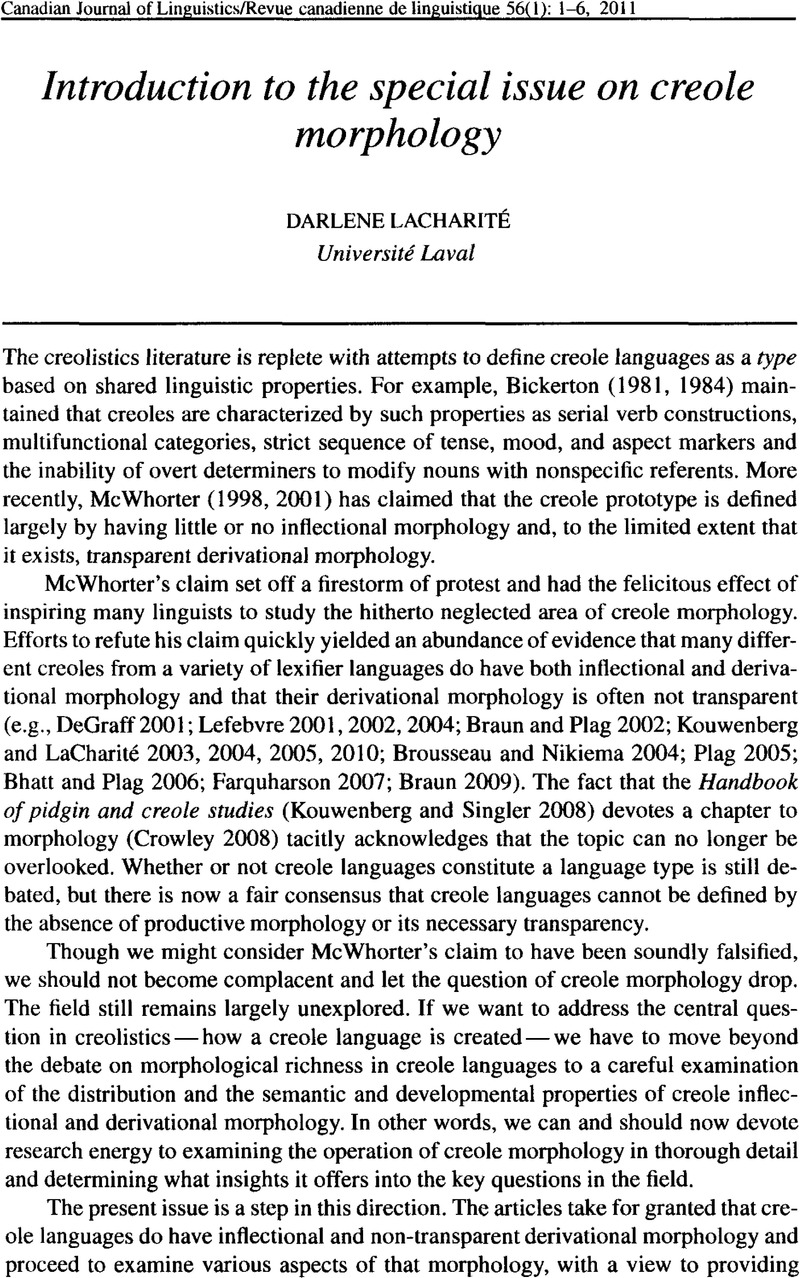No CrossRef data available.
Article contents
Introduction to the special issue on creole morphology
Published online by Cambridge University Press: 27 June 2016
Abstract
An abstract is not available for this content so a preview has been provided. Please use the Get access link above for information on how to access this content.

- Type
- Other
- Information
- Canadian Journal of Linguistics/Revue canadienne de linguistique , Volume 56 , Issue 1 , March 2011 , pp. 1 - 6
- Copyright
- Copyright © Canadian Linguistic Association/Association canadienne de linguistique 2011
References
Aceto, Michael. 2002. Going back to the beginning: Describing the (nearly) undocumented Anglophone creoles of the Caribbean. In Pidgin and creole linguistics in the twenty-first century, ed. Gilbert, Glenn, 93–120. New York: Peter Lang.Google Scholar
Bhatt, Parth and Plag, Ingo. 2006. The structure of Creole words: Segmental, syllabic and morphological aspects. Tübingen: Max Niemeyer Verlag.Google Scholar
Bickerton, Derek. 1984. The language bioprogram hypothesis. Behavioral and Brain Sciences 7:173–221.Google Scholar
Braun, Maria. 2009. Word-formation and creolization: The case of early Sranan. Tübingen: Max Niemeyer Verlag.Google Scholar
Braun, Maria and Plag, Ingo. 2002. How transparent is Creole morphology? A study of early Sranan word-formation. In Yearbook of morphology, ed. Booij, Geert and Marie, J. van, 81–104. Dordrecht: Kluwer.Google Scholar
Brousseau, Anne-Marie and Nikiema, Emmanuel. 2004. Towards a derivational inventory of St. Lucian. Paper presented at the biennial meeting of the Society for Caribbean Linguistics, Curaçao.Google Scholar
Crowley, Terry. 2008. Pidgin and creole morphology. In The handbook of pidgin and creole studies, ed. Kouwenberg, Silvia and Singler, John, 74–97. Maiden, MA: Wiley-Blackwell.Google Scholar
DeCamp, David. 1971. Towards a generative analysis of a post-creole speech continuum. In Pidginization and creolization of languages, ed. Hymes, Dell, 349–370. Cambridge: Cambridge University Press.Google Scholar
DeGraff, Michel. 2001. Morphology in creole genesis: Linguistics and ideology. In Ken Hale: A life in language, ed. Kenstowicz, Michael, 53–121. Cambridge, MA: MIT Press.Google Scholar
Farquharson, Joseph. 2007. Creole morphology revisited. In Deconstructing creole, ed. Ansaldo, Umberto, Matthews, Stephen, and Lim, Lisa, 21–37. Amsterdam: John Benjamins.Google Scholar
Kegl, Judy. 2008. Signed languages in pidgin and creole studies. In The handbook of pidgin and creole studies, ed. Kouwenberg, Silvia and Singler, John, 491–511. Maiden, MA: Wiley-Blackwell.Google Scholar
Kegl, Judy, Senghas, Ann, and Coppola, Marie. 2001. Creation through contact: Sign language emergence and sign language change in Nicaragua. In Language creation and language change, ed. DeGraff, Michel, 179–237. Cambridge, MA: MIT Press.Google Scholar
Kouwenberg, Silvia and LaCharité, Darlene. 2003. The meanings of “more of the same”: Iconicity in reduplication and the evidence for substrate transfer in the genesis of Caribbean Creole languages. In Twice as meaningful: Reduplication in pidgins, creoles and other contact languages, ed. Kouwenberg, Silvia, 7–18. London: Battlebridge Publications.Google Scholar
Kouwenberg, Silvia and LaCharité, Darlene. 2004. Echoes of Africa: Reduplication in Caribbean Creole and Niger-Congo languages. Journal of Pidgin and Creole Languages 19: 285–331.Google Scholar
Kouwenberg, Silvia and LaCharité, Darlene. 2005. Less is more: Evidence from diminutive reduplication in Caribbean Creole languages. In Studies on reduplication, ed. Hurch, Bernard, 531–543. Berlin: Mouton de Gruyter.Google Scholar
Kouwenberg, Silvia and LaCharité, Darlene. 2010. The typology of Caribbean Creole reduplication. Journal of Pidgin and Creole Languages 26:194–218.Google Scholar
Kouwenberg, Silvia and Singler, John. 2008. The handbook of pidgin and creole studies. Maiden, MA: Wiley-Blackwell.Google Scholar
Lefebvre, Claire. 2001. On the semantic opacity of creole languages. Journal of Pidgin and Creole Languages 16:321–353.Google Scholar
Lefebvre, Claire. 2002. The emergence of productive morphology in creole languages: The case of Haitian Creole. In Yearbook of morphology vol. 2, ed. Booij, Geert and Marie, Jaap van, 35–80. Dordrecht: Kluwer.Google Scholar
Lefebvre, Claire. 2004. Issues in the study of pidgin and creole languages. Amsterdam: John Benjamins.Google Scholar
McWhorter, John. 1998. Identifying the Creole prototype: Vindicating a typological class. Language 74:788–818.Google Scholar
McWhorter, John. 2001. Defining “creole” as a synchronic term. In Degrees of restructuring in Creole languages, ed. Neumann-Holzschuh, Ingrid and Schneider, Edgar W., 85–124. Amsterdam: John Benjamins.Google Scholar
Mufwene, Salikoko. 2010. SLA and the emergence of creoles. Studies in Second Language Acquisition 32:359–400.Google Scholar
Plag, Ingo. 2005. Morphology in pidgins and creoles. In Encyclopedia of language and linguistics, 2nd ed., vol. 8, ed. Brown, Keith, 304–308. Oxford: Elsevier.Google Scholar
Rickford, John. 1987. Dimensions of a creole continuum: History, texts, and linguistic analysis of Guyanese Creole. Stanford: Stanford University Press.Google Scholar
Syea, Anand. 2002. Future developments in creole languages: Moving away from analyticity. In Pidgin and creole linguistics in the twenty-first century, ed. Gilbert, Glenn, 199–228. New York: Peter Lang.Google Scholar
Whinnom, Keith. 1971. Linguistic hybridization and the “special case” of pidgins and creoles. In Pidginization and creolization of languages, ed. Hymes, Dell, 91–115. Cambridge: Cambridge University Press.Google Scholar




